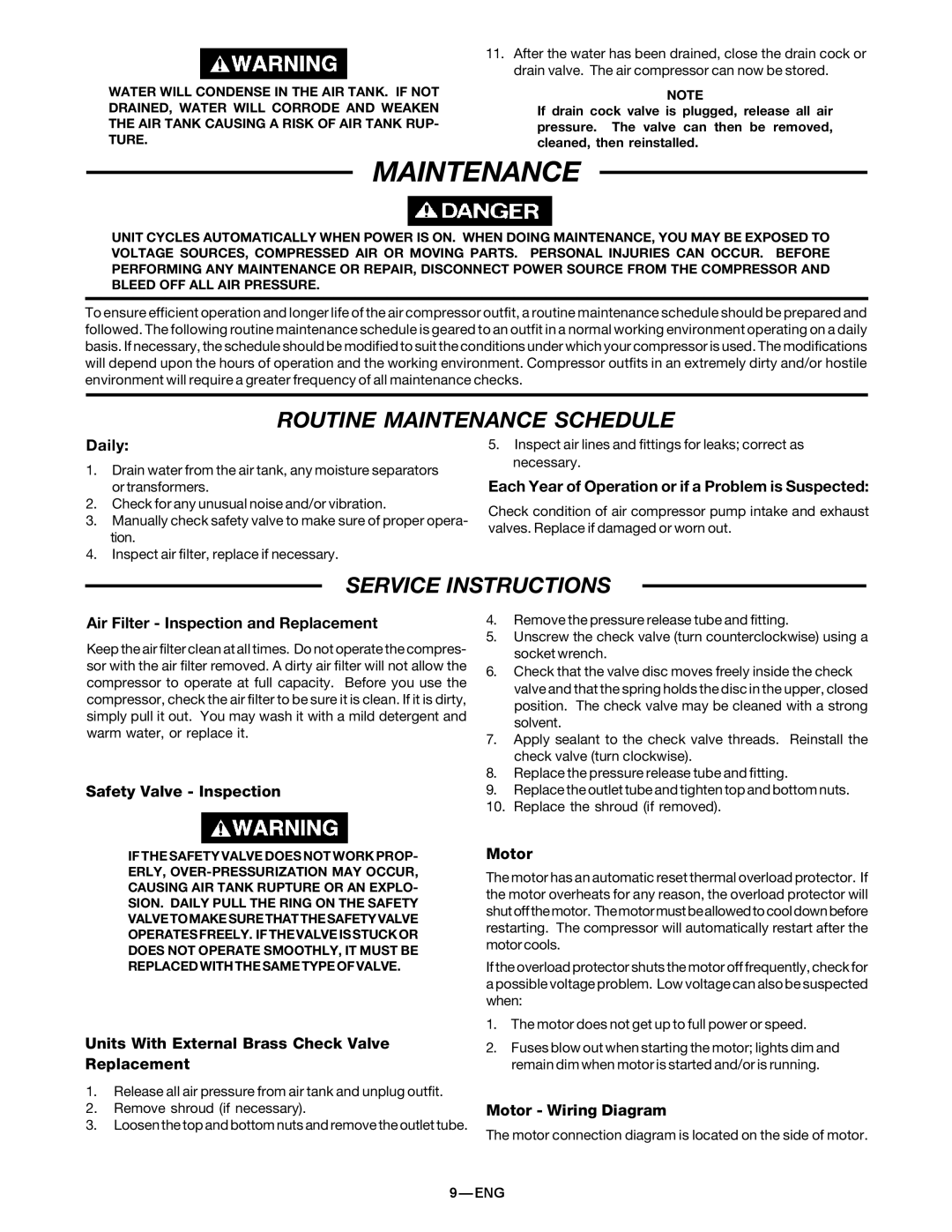
WATER WILL CONDENSE IN THE AIR TANK. IF NOT DRAINED, WATER WILL CORRODE AND WEAKEN THE AIR TANK CAUSING A RISK OF AIR TANK RUP- TURE.
11.After the water has been drained, close the drain cock or drain valve. The air compressor can now be stored.
NOTE
If drain cock valve is plugged, release all air pressure. The valve can then be removed, cleaned, then reinstalled.
MAINTENANCE
UNIT CYCLES AUTOMATICALLY WHEN POWER IS ON. WHEN DOING MAINTENANCE, YOU MAY BE EXPOSED TO VOLTAGE SOURCES, COMPRESSED AIR OR MOVING PARTS. PERSONAL INJURIES CAN OCCUR. BEFORE PERFORMING ANY MAINTENANCE OR REPAIR, DISCONNECT POWER SOURCE FROM THE COMPRESSOR AND BLEED OFF ALL AIR PRESSURE.
To ensure efficient operation and longer life of the air compressor outfit, a routine maintenance schedule should be prepared and followed. The following routine maintenance schedule is geared to an outfit in a normal working environment operating on a daily basis. If necessary, the schedule should be modified to suit the conditions under which your compressor is used. The modifications will depend upon the hours of operation and the working environment. Compressor outfits in an extremely dirty and/or hostile environment will require a greater frequency of all maintenance checks.
ROUTINE MAINTENANCE SCHEDULE
Daily:
1.Drain water from the air tank, any moisture separators or transformers.
2.Check for any unusual noise and/or vibration.
3.Manually check safety valve to make sure of proper opera- tion.
4.Inspect air filter, replace if necessary.
5.Inspect air lines and fittings for leaks; correct as necessary.
Each Year of Operation or if a Problem is Suspected:
Check condition of air compressor pump intake and exhaust valves. Replace if damaged or worn out.
SERVICE INSTRUCTIONS
Air Filter - Inspection and Replacement
Keep the air filter clean at all times. Do not operate the compres- sor with the air filter removed. A dirty air filter will not allow the compressor to operate at full capacity. Before you use the compressor, check the air filter to be sure it is clean. If it is dirty, simply pull it out. You may wash it with a mild detergent and warm water, or replace it.
Safety Valve - Inspection
IF THE SAFETY VALVE DOES NOT WORK PROP- ERLY,
Units With External Brass Check Valve Replacement
1.Release all air pressure from air tank and unplug outfit.
2.Remove shroud (if necessary).
3.Loosen the top and bottom nuts and remove the outlet tube.
4.Remove the pressure release tube and fitting.
5.Unscrew the check valve (turn counterclockwise) using a socket wrench.
6.Check that the valve disc moves freely inside the check valve and that the spring holds the disc in the upper, closed position. The check valve may be cleaned with a strong solvent.
7.Apply sealant to the check valve threads. Reinstall the check valve (turn clockwise).
8.Replace the pressure release tube and fitting.
9.Replace the outlet tube and tighten top and bottom nuts.
10.Replace the shroud (if removed).
Motor
The motor has an automatic reset thermal overload protector. If the motor overheats for any reason, the overload protector will shutoffthemotor. Themotormustbeallowedtocooldownbefore restarting. The compressor will automatically restart after the motor cools.
If the overload protector shuts the motor off frequently, check for a possible voltage problem. Low voltage can also be suspected when:
1.The motor does not get up to full power or speed.
2.Fuses blow out when starting the motor; lights dim and remain dim when motor is started and/or is running.
Motor - Wiring Diagram
The motor connection diagram is located on the side of motor.
